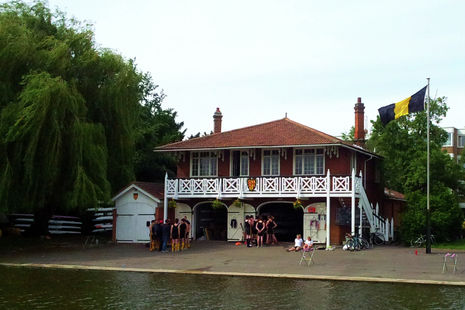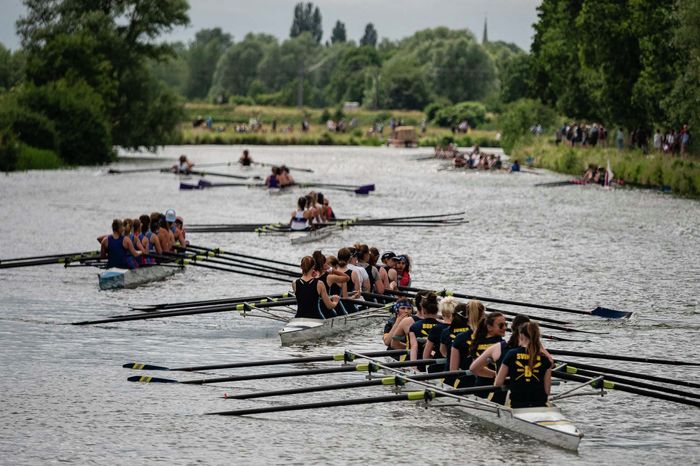‘A full-time job with overtime’: should disparities change the way we approach Bumps?
Louise Crary delves into inequalities between college boat clubs, and the lives and worries of rowers at the poorest clubs on the Cam

Every year, thousands of Cambridge students take part in rowing with their college, be it for one or two sessions in Michaelmas, or all the way through to the end of Mays. Yet with the 200th anniversary of Bumps on the horizon, it feels a fitting moment to take a deeper look into the highly unequal world of college rowing today.
One issue which has previously surfaced is the extreme disparities between the funds available to different college boat clubs. In 2024 it was reported that St John’s College had given over £170,000 in funding to its Lady Margaret Boat Club (LMBC), while Lucy Cavendish’s Boat Club had only been granted £1,951. The club with the second least amount of funding was Newnham, which was allocated just £9,000 – a marginal amount in comparison to LMBC, or the £32,768 that Caius’ Boat Club received.
While rowing is an undoubtedly historic sport for the University of Cambridge as a whole, there are certain boat clubs on the Cam that have a more decorated and distinguished past than others. Before the most recent thirteen Cambridge colleges had been founded, LMBC and Trinity First and Third had won the Ladies Challenge Plate at the prestigious Henley Regatta seven times between them.
“Up to 85 times more funding and centuries more experience”
However, pedigree and former glory is far from the only distinction between college boat clubs – the oldest and most charted boat clubs are also the richest ones on the Cam today. But as Bumps approaches its double centenary, it’s crucial to shine a light on the harsher realities for rowers outside of the richer, more established clubs.
While some amount of money is required to perform well at a high level in any sport, the threshold needed for a rowing club’s basic functions is exceptional. In order to buy an ‘Eight’ (the boat needed for each crew that races in Bumps), a boat club has to spend over £30,000; ergs cost around £1,000 each; eight standard sweep oars are around £4,000; and all the gear required for coxing can amount to £1,000. This doesn’t include boat house fees, coaching, or funding boat club events. Newer boat clubs which have less money, have had less time to create an alumni network and build an inventory of boats and rowing equipment, and have missed out on securing a space on the Cam for a boat house, are at a serious disadvantage.
Richer colleges having an advantage in college sports won’t come as a surprise to anybody. The specific consequences of these differences for rowers in newer and less wealthy boat clubs, however, calls into question the way that we view success in Bumps and on the Cam. Unlike in 1827, there are no longer seventeen male crews whose colleges have access to similar equipment and comparable funds battling it out for the headship each Spring. The participants today are much more varied in every regard.
“If we matched Newnham and got £9,000, that would be a life-changing difference”
2024-2025 Lucy Cavendish Women’s captain, PhD student Lauren Allegretti, had first picked up an oar only nine months before she began her role as captain, and describes this past year as a very steep learning curve. In the boat club which receives the least amount of college funding, all of the work that goes into keeping it functioning falls into the hands of students. Lauren’s jobs included: overseeing the structuring of all land and water workouts, coordinating coaching schedules, handling selection logistics, communicating schedules and goals to the team and coordinating the availability, commitment, and outing plans of up to 40 girls.
This rather extensive list amounts to a commitment that was akin to “a full-time job with overtime because you’re working on the weekends as well.” Though Lauren made clear that she learned a lot during this year, and knew going into it that “leadership is service,” she also described some of the difficulties of the role. “I was coach, I was cox, I was captain, I was a rower, and that can be extremely difficult to balance on top of school and day to day life,” she said.
When asked what the impact of increased funding would be on the boat club captain’s role at Lucy Cavendish, she replied: “If we matched Newnham and got £9,000, that would be a life-changing difference. That’s even amounts of coaching for each boat, that’s more scholarships, functioning equipment…” Many of the roles that Lauren and other students at Lucy Cav were playing were those that a head coach would have filled at another college.
Senior rowers at newer, smaller boat clubs, as Lauren says, “wear a lot of hats,” and this can take away from their capacity to perform as athletes themselves. Lauren and other rowers take on practically full-time jobs for their boat clubs, on top of being Cambridge students, displaying a level of capability which goes far beyond their athletic capacity. So, in this final year before we arrive at a Cambridge rowing milestone, we ought to truly appreciate the work that students at these young boat clubs put in, not to win every race, but simply to keep the boat clubs going. The bumps of 2027 will look very different than it did in 1827, and that is not in itself a bad thing. It will just require a more nuanced outlook from audiences on the bank to understand that the results on the CUCBC Bumps spreadsheet don't reveal all the struggles and successes of many of today’s boat clubs.
 News / Cambridge academics stand out in King’s 2026 Honours List2 January 2026
News / Cambridge academics stand out in King’s 2026 Honours List2 January 2026 Interviews / You don’t need to peak at Cambridge, says Robin Harding31 December 2025
Interviews / You don’t need to peak at Cambridge, says Robin Harding31 December 2025 Comment / What happened to men at Cambridge?31 December 2025
Comment / What happened to men at Cambridge?31 December 2025 News / AstraZeneca sues for £32 million over faulty construction at Cambridge Campus31 December 2025
News / AstraZeneca sues for £32 million over faulty construction at Cambridge Campus31 December 2025 Features / “It’s a momentary expression of rage”: reforming democracy from Cambridge4 January 2026
Features / “It’s a momentary expression of rage”: reforming democracy from Cambridge4 January 2026










